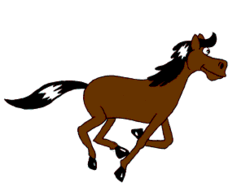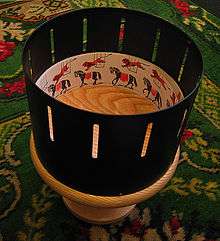Animated cartoon

An animated cartoon is a film for the cinema, television or computer screen, which is made using sequential drawings,[Note 1] as opposed to animations in general, which include films made using clay, puppet and other means.
History
Early years
Early examples of attempts to capture the phenomenon of motion into a still drawing can be found in paleolithic cave paintings, where animals are often depicted with multiple legs in superimposed positions, clearly attempting to convey the perception of motion.[1]
The phenakistoscope (1832), zoetrope (1834) and praxinoscope (1877), as well as the common flip book, were early animation devices to produce movement from sequential drawings using technological means, but did not develop further until the advent of motion picture film.
-

An 1893 phenakistoscope disc by Eadweard Muybridge.[Note 1]
-

Simulated mirror view of the disc
-

An 1886 Flip book
-

A modern replica of a Victorian zoetrope (1834)
Cite error: There are <ref group=Note> tags on this page, but the references will not show without a {{reflist|group=Note}} template (see the help page).
Silent era
.webm.jpg)
The first animated projection (screening) was created in France, by Charles-Émile Reynaud, who was a French science teacher. Reynaud created the Praxinoscope in 1877 and the Théâtre Optique in December 1888. On 28 October 1892, he projected the first animation in public, Pauvre Pierrot, at the Musée Grévin in Paris. This film is also notable as the first known instance of film perforations being used. His films were not photographed, but drawn directly onto the transparent strip. In 1900, more than 500,000 people had attended these screenings.
The first (photographed) animated projection was Humorous Phases of Funny Faces (1906) by newspaper cartoonist J. Stuart Blackton, one of the co-founders of the Vitagraph Company arrived. In the movie, a cartoonist's line drawings of two faces were 'animated' (or came to life) on a blackboard. The two faces smiled and winked, and the cigar-smoking man blew smoke in the lady's face; also, a circus clown led a small dog to jump through a hoop.
The first animated projection in the traditional sense (i.e., on motion picture film) was Fantasmagorie by the French director Émile Cohl in 1908. This was followed by two more films, Le Cauchemar du fantoche [The Puppet's Nightmare,, now lost] and Un Drame chez les fantoches [A Puppet Drama, called The Love Affair in Toyland for American release and Mystical Love-Making for British release], all completed in 1908.
One of the very first successful animated cartoons was Gertie the Dinosaur (1914) by Winsor McCay. It is considered the first example of true character animation. At first, animated cartoons were black-and-white and silent. Felix the Cat and Oswald the Lucky Rabbit are notable examples.
"Golden Age"
From the 1920s to 1960s, theatrical cartoons were produced in huge numbers, and usually shown before a feature film in a movie theater. Disney (distributed by Pat Powers, then Columbia, then United Artists, then RKO, then independently), Fleischer (distributed by Paramount), Warner Bros., MGM, and UPA (distributed by Columbia) were the largest studios producing these 5- to 10-minute "shorts." Other studios included Walter Lantz (distributed by Universal), DePatie-Freleng (distributed by United Artists), Charles Mintz Studios (later Screen Gems) (distributed by Columbia), Famous Studios (distributed by Paramount), and Terrytoons (distributed by 20th Century Fox).
The first cartoon to use a soundtrack was in 1926 with Max Fleischer's My Old Kentucky Home. However the Fleischers used a De Forest sound system and the sound was not completely synchronized with the film. Walt Disney's 1928 cartoon Steamboat Willie starring Mickey Mouse was the first to use a click track during the recording session, which produced better synchronism. "Mickey Mousing" became a term for any movie action (animated or live action) that was perfectly synchronized with music. The music used is original most of the time, but musical quotation is often employed. Animated characters usually performed the action in "loops," i.e., drawings were repeated over and over.
Although other producers had made films earlier using 2-strip color, Disney produced the first cartoon in 3-strip Technicolor, Flowers and Trees, in 1932. Technicians at the Fleischer studio invented rotoscoping, in which animators trace live action in order to make animation look more realistic. However, rotoscoping made the animation look stiff and the technique was later used more for studying human and animal movement, rather than directly tracing and copying filmed movements.[2]
Later, other movie technologies were adapted for use in animation, such as multiplane cameras with The Old Mill (1937), stereophonic sound in Fantasia (1940), widescreen processes with the feature-length Lady and the Tramp (1955), and even 3D with Lumber Jack-Rabbit.
Today, traditional animation uses traditional methods, but is aided by computers in certain areas. This gives the animator new tools not available that could not be achieved using old techniques.
Feature films
In 1917, Italian-Argentine cartoonist Quirino Cristiani created the first animated feature ever made, El Apóstol, utilizing cutout animation; however, a fire that destroyed producer Federico Valle's film studio incinerated the only known copy of the film, and it is now considered lost.
In 1937, Disney created the first sound and color animated feature film Snow White and the Seven Dwarfs.
The name "animated cartoon" is generally not used when referring to full-length animated productions, since the term more or less implies a "short." Huge numbers of animated feature films were, and are still, produced.
Television
Competition from television drew audiences away from movie theaters in the late 1950s, and the theatrical cartoon began its decline. Today, animated cartoons for American audiences are produced mostly for television.
American television animation of the 1950s featured quite limited animation styles, highlighted by the work of Jay Ward on Crusader Rabbit. Chuck Jones coined the term "illustrated radio" to refer to the shoddy style of most television cartoons that depended more on their soundtracks than visuals. Other notable 1950s programs include UPA's Gerald McBoing Boing, Hanna-Barbera's Huckleberry Hound and Quick Draw McGraw, and rebroadcast of many classic theatrical cartoons from Universal's Walter Lantz, Warner Brothers, MGM, and Disney.
The Hanna-Barbera cartoon, The Flintstones, was the first successful primetime animated series in the United States, running from 1960-66 (and in reruns since). While many networks followed the show's success by scheduling other cartoons in the early 1960s, including Scooby-Doo, Where Are You!, The Jetsons, Top Cat, and The Alvin Show, none of these programs survived more than a year (save Scooby-Doo, which, despite not being a primetime cartoon, has managed to stay afloat for over four decades). However, networks found success by running these shows as Saturday morning cartoons, reaching smaller audiences with more demographic unity among children. Television animation for children flourished on Saturday morning, on cable channels like Nickelodeon, Disney Channel and Cartoon Network, PBS Kids, and in syndicated afternoon timeslots.
The scheduling constraints of the TV animation process, notably issues of resource management, led to the development of various techniques known now as limited animation. Full-frame animation ("on ones") became rare in its use outside of theatrical productions in the United States.
Primetime cartoons for mature audiences were virtually non-existent in the mainstream of the United States until 1990s hit The Simpsons ushered in a new era of adult animation. Now, "adult animation" programs, such as Aeon Flux, Beavis and Butt-head, South Park, Family Guy, The Cleveland Show, American Dad!, Bob's Burgers, Aqua Teen Hunger Force (currently known as Aqua TV Show Show), and Futurama have increased the number of animated sitcoms on prime-time and evening American television. In addition, animated works from other countries (notably Japan) have had varying levels of airplay in the United States since the 1960s.
Commercial animation
Animation has been very popular in television commercials, both due to its graphic appeal, and the humour it can provide. Some animated characters in commercials have survived for decades, such as Snap, Crackle and Pop in advertisements for Kellogg's cereals.
In 1957, "Louie the Fly" made his first appearance on Australian TV as the cartoon antagonist for Mortein, an Australian brand of household insecticide and was drawn and animated by Geoffry Morgan Pike. In a jingle created by Bryce Courtenay, it has been used in animated TV commercials since 1962, he proudly sings of his own dirtiness, claiming to be afraid of no-one except "the man with the can of Mortein."
The legendary animation director Tex Avery was the producer of the first Raid "Kills Bugs Dead" commercials in 1966, which were very successful for the company. The concept has been used in many countries since.
See also
- Animation
- Computer animation
- Cartoon
- Traditional animation
- List of animated short series
- List of animated television series
- List of animated feature-length films
- List of animation studios
Notes
- ↑ This method is also called traditional animation creation method.
References
Bibliography
- Barrier, J. Michael (1999). Hollywood Cartoons: American Animation in Its Golden Age. New York: Oxford University Press. ISBN 0-19-503759-6.
- Bendazzi, Giannalberto (1994). Cartoons: One Hundred Years of Cinema Animation. Bloomington, Indiana: Indiana University Press. ISBN 0-253-20937-4.
- Maltin, Leonard (1980). Of Mice and Magic: A History of American Animated Cartoons. New York: Plume. ISBN 0-452-25993-2.
- Stabile, Carol and Mark Harrison, eds. Prime Time Animation: Television Animation and American Culture. London: Routledge, 2003. ISBN 0-415-28326-4.
- Stephenson, Ralph (1973). The Animated Film. London: Tantivity Press. ISBN 0-498-01202-6.
External links
- Animated Films
- The making of an animated cartoon
- The History of the Discovery of Cinematography
- Complete list of Soviet animated cartoons (in English, with descriptions. Also includes cartoons from all of the countries that the Soviet Union split up into)
- Why Does Mickey Mouse Have Only Three Fingers? Matthew Alice Straight From The Hip in the San Diego Reader